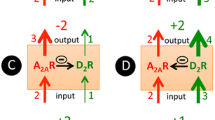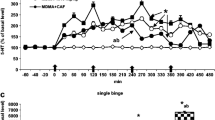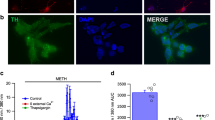Abstract
Rationale
Caffeine exacerbates the acute toxicity of 3,4-methylenedioxymethamphetamine (MDMA, ‘ecstasy’) in rats characterised by hyperthermia, tachycardia and lethality. Depletion of central catecholamine stores and dopamine D1 receptor blockade have been reported to attenuate the ability of caffeine to exacerbate MDMA-induced hyperthermia.
Objectives
Here, we investigate whether dopamine D1 and D2 receptors mediate the effects of caffeine on MDMA-induced changes in body temperature, heart rate and locomotor activity.
Methods
All parameters were recorded continuously in individually housed rats using bioradiotelemetry from 1 h prior to 4 h following caffeine (10 mg/kg, s.c.) and/or MDMA (10 mg/kg, s.c.) administration.
Results
Co-administration of caffeine with MDMA provoked a switch from MDMA-induced hypothermia and bradycardia to hyperthermia and tachycardia without influencing MDMA-induced hyperlocomotion. Pre-treatment with a specific dopamine D1/5 antagonist SCH 23390 (1 mg/kg) enhanced MDMA-induced hypothermia and blocked the ability of caffeine to provoke a switch from MDMA-induced hypothermia to hyperthermia. Furthermore, SCH 23390 blocked MDMA-induced hyperactivity and the ability of caffeine to promote a tachycardic response to MDMA. By contrast, pre-treatment with the selective D2 antagonist, sulpiride (100 mg/kg) blocked MDMA-induced hypothermia, failed to influence the ability of caffeine to promote tachycardia whilst enhancing MDMA-induced hyperactivity.
Conclusions
Our results highlight the importance of dopamine D1 and D2 receptors in shaping the behavioural and physiological response to MDMA and suggest that the ability of caffeine to provoke MDMA-induced toxicity is associated with the promotion of dopamine D1 over D2 receptor-related responses.



Similar content being viewed by others
References
Abrahams TP, Cuntapay M, Varner KJ (1996) Sympathetic nerve responses elicited by cocaine in anesthetized and conscious rats. Physiol Behav 59:109–115
Armstrong LE, Casa DJ, Maresh CM, Ganio MS (2007) Caffeine, fluid-electrolyte balance, temperature regulation, and exercise-heat tolerance. Exerc Sport Sci Rev 35:135–140
Badon LA, Hicks A, Lord K, Ogden BA, Meleg-Smith S, Varner KJ (2002) Changes in cardiovascular responsiveness and cardiotoxicity elicited during binge administration of Ecstasy. J Pharmacol Exp Ther 302:898–907
Ball KT, Budreau D, Rebec GV (2003) Acute effects of 3, 4-methylenedioxymethamphetamine on striatal single-unit activity and behavior in freely moving rats: differential involvement of dopamine D(1) and D(2) receptors. Brain Res 994(2):203–215
Bankson MG, Cunningham KA (2002) Pharmacological studies of the acute effects of (+)-3, 4-methylenedioxymethamphetamine on locomotor activity: role of 5-HT(1B/1D) and 5-HT(2) receptors. Neuropsychopharmacol 26(1):40–52
Benoit-Marand M, Borrelli E, Gonon F (2001) Inhibition of dopamine release via presynaptic D2 receptors: time course and functional characteristics in vivo. J Neurosci 21:9134–9141
Benturquia N, Courtin C, Noble F, Marie-Claire C (2008) Involvement of D1 dopamine receptor in MDMA-induced locomotor activity and striatal gene expression in mice. Brain Res 1211:1–5
Blessing WW, Seaman B, Pedersen NP, Ootsuka Y (2003) Clozapine reverses hyperthermia and sympathetically mediated cutaneous vasoconstriction induced by 3, 4-methylenedioxymethamphetamine (ecstasy) in rabbits and rats. J Neurosci 23:6385–6391
Burgess C, O’Donohoe A, Gill M (2000) Agony and ecstasy: a review of MDMA effects and toxicity. Eur Psychiatry 15:287–294
Camarasa J, Pubill D, Escubedo E (2006) Association of caffeine to MDMA does not increase antinociception but potentiates adverse effects of this recreational drug. Brain Res 1111:72–82
Cavero I, Massingham R, Lefevere-Borg F (1982) Peripheral dopamine receptors, potential targets for a new class of antihypertensive agents. Part II: sites and mechanisms of action of dopamine receptor agonists. Life Sci 31:1059–1069
Cavero I, Thiry C, Pratz J, Lawson K (1987) Cardiovascular characterization of DA-1 and DA-2 dopamine receptor agonists in anesthetized rats. Clin Exp Hypertens 9:931–952
Chaperon F, Tricklebank MD, Unger L, Neijt HC (2003) Evidence for regulation of body temperature in rats by dopamine D2 receptor and possible influence of D1 but not D3 and D4 receptors. Neuropharmacology 44:1047–1053
Chitravanshi VC, Calaresu FR (1992) Dopamine microinjected into the nucleus ambiguous elicits vagal bradycardia in spinal rats. Brain Res 583:308–311
Cornelis MC, El-Sohemy A (2007) Coffee, caffeine, and coronary heart disease. Curr Opin Clin Nutr Metab Care 10:745–751
Cragg SJ, Greenfield SA (1997) Differential autoreceptor control of somatodendritic and axon terminal dopamine release in substantia nigra, ventral tegmental area, and striatum. J Neurosci 17:5738–5746
Dias FRC, Carey RJ, Carrera MP (2006) Conditioned locomotion induced by unilateral intrastriatal administration of apomorphine: D2 receptor activation is critical but not the expression of the unconditioned response. Brain Res 1083:85–95
Frantz KJ, Van Hartesveldt C (1995) Sulpiride antagonizes the biphasic locomotor effects of quinpirole in weanling rats. Psychopharmacology (Berl) 119:299–304
Freedman RR, Johanson CE, Tancer ME (2005) Thermoregulatory effects of 3, 4-methylenedioxymethamphetamine (MDMA) in humans. Psychopharmacol 183:248–256
Gouzoulis-Mayfrank E, Daumann J (2006) The confounding problem of polydrug use in recreational ecstasy/MDMA users: a brief overview. J Psychopharmacol 20:188–193
Green AR, Mechan AO, Elliott JM, O’Shea E, Colado MI (2003) The pharmacology and clinical pharmacology of 3, 4-methylenedioxymethamphetamine (MDMA, “ecstasy”). Pharmacol Rev 55:463–508
Green AR, O’Shea E, Saadat KS, Elliott JM, Colado MI (2005) Studies on the effect of MDMA (‘ecstasy’) on the body temperature of rats housed at different ambient room temperatures. Br J Pharmacol 146:306–312
Hall DA, Powers JP, Gulley JM (2009) Blockade of D1 dopamine receptors in the medial prefrontal cortex attenuates amphetamine- and methamphetamine-induced locomotor activity in the rat. Brain Res 1300:51–57
Harkin A, Kelly JP, Frawley J, O’Donnell JM, Leonard BE (2000) Test conditions influence the response to a drug challenge in rodents. Pharmacol Biochem Behav 65:389–398
Harkin A, O’Donnell JM, Kelly JP (2002a) A study of VitalView for behavioural and physiological monitoring in laboratory rats. Physiol Behav 77:65–77
Harkin A, Connor TJ, O’Donnell JM, Kelly JP (2002b) Physiological and behavioral responses to stress: what does a rat find stressful? Lab Anim (NY) 31:42–50
Hasegawa H, Meeusen R, Sarre S, Diltoer M, Piacentini MF, Michotte Y (2005) Acute dopamine/norepinephrine reuptake inhibition increases brain and core temperature in rats. J Appl Physiol 99:1397–1401
Jackson DM, Westlind-Danielsson A (1994) Dopamine receptors: molecular biology, biochemistry and behavioural aspects. Pharmacol Ther 64:291–370
Kaneno S, Fukamauchi F, Komatsu H, Koyama K, Ikawa K (2001) Reversal effect of sulpiride on rotational behaviour of rats with unilateral frontal cortex ablation: an alternative explanation for the pharmacological mechanism of its antidepressant effect. Behav Pharmacol 12:69–73
Kiyatkin EA (2002) Dopamine in the nucleus accumbens: cellular actions, drug- and behavior-associated fluctuations, and a possible role in an organism’s adaptive activity. Behav Brain Res 137:27–46
Knuepfer MM, Branch CA (1992) Cardiovascular responses to cocaine are initially mediated by the central nervous system in rats. J Pharmacol Exp Ther 263:734–741
LaHoste GJ, Henry BL, Marshall JF (2000) Dopamine D1 receptors synergize with D2, but not D3 or D4, receptors in the striatum without the involvement of action potentials. J Neurosci 20:6666–6671
Langer SZ (1997) 25 years since the discovery of presynaptic receptors: present knowledge and future perspectives. Trends Pharmacol Sci 18:95–99
Maj J, Rogóz Z, Skuza G, Kolodziejczyk K (1997) The behavioural effects of pramipexole, a novel dopamine receptor agonist. Eur J Pharmacol 324:31–37
McNamara R, Kerans A, O’Neill B, Harkin A (2006) Caffeine promotes hyperthermia and serotonergic loss following co-administration of the substituted amphetamines, MDMA (“Ecstasy”) and MDA (“Love”). Neuropharmacology 50:69–80
McNamara R, Maginn M, Harkin A (2007) Caffeine induces a profound and persistent tachycardia in response to MDMA (“Ecstasy”) administration. Eur J Pharmacol 555:194–198
Mechan AO, Esteban B, O’Shea E, Elliott JM, Colado MI, Green AR (2002) The pharmacology of the acute hyperthermic response that follows administration of 3, 4-methylenedioxymethamphetamine (MDMA, ‘ecstasy’) to rats. Br J Pharmacol 135(1):170–180
Milroy CM, Clark JC, Forrest AR (1996) Pathology of deaths associated with “ecstasy” and “eve” misuse. J Clin Pathol 49:149–153
Nava F, Carta G, Gessa GL (2000) Permissive role of dopamine D2 receptors in the hypothermia induced by [delta]9-tetrahydrocannabinol in rats. Pharmacol Biochem Behav 66:183–187
Nawrot P, Jordan S, Eastwood J, Rotstein J, Hugenholtz A, Feeley M (2003) Effects of caffeine on human health. Food Addit Contam 20:1–30
O’Cain PA, Hletko SB, Ogden BA, Varner KJ (2000) Cardiovascular and sympathetic responses and reflex changes elicited by MDMA. Physiol Behav 70:141–148
O’Tuathaigh CP, Moran PM (2004) The effect of sulpiride on amphetamine-induced disruption of overshadowing in the rat. Prog Neuropsychopharmacol Biol Psychiatry 28:1249–1253
Paul EMP, Pamela JH, Jonathan AS (2002) Time window of autoreceptor-mediated inhibition of limbic and striatal dopamine release. Synapse 44:15–22
Risbrough VB, Masten VL, Caldwell S, Paulus MP, Low MJ, Geyer MA (2006) Differential contributions of dopamine D1, D2, and D3 receptors to MDMA-induced effects on locomotor behavior patterns in mice. Neuropsychopharmacol 31:2349–2358
Scholey AB, Parrott AC, Buchanan T, Heffernan TM, Ling J, Rodgers J (2004) Increased intensity of Ecstasy and polydrug usage in the more experienced recreational Ecstasy/MDMA users: a WWW study. Addict Behav 29:743–752
Shieh GJ, Walters DE (1996) Stimulating dopamine D1 receptors increases the locomotor activity of developing rats. Eur J Pharmacol 311:103–107
Shioda K, Nisijima K, Yoshino T, Kuboshima K, Iwamura T, Yui K, Kato S (2008) Risperidone attenuates and reverses hyperthermia induced by 3, 4-methylenedioxymethamphetamine (MDMA) in rats. Neurotoxicology 29:1030–1036
Tauscher J, Hussain T, Agid O, Verhoeff NP, Wilson AA, Houle S, Remington G, Zipursky RB, Kapur S (2004) Equivalent occupancy of dopamine D1 and D2 receptors with clozapine: differentiation from other atypical antipsychotics. Am J Psychiatry 161:1620–1625
Vanattou-Saïfoudine N, McNamara R, Harkin A (2010) Mechanisms mediating the ability of caffeine to influence MDMA (“Ecstasy”)-induced hyperthermia in rats. Br J Pharmacol (in press)
Velasco M, Luchsinger A (1998) Dopamine: pharmacologic and therapeutic aspects. Am J Ther 5:37–43
Vezina P, Blanc G, Glowinski J, Tassin JP (1991) Opposed behavioural outputs of increased dopamine transmission in prefrontocortical and subcortical areas: a role for the cortical D-1 dopamine receptor. Eur J Neurosci 3:1001–1007
Von Huben SN, Lay CC, Crean RD, Davis SA, Katner SN, Taffe MA (2007) Impact of ambient temperature on hyperthermia induced by (+/−)3, 4-methylenedioxymethamphetamine in rhesus macaques. Neuropsychopharmacol 32:673–681
Waddington JL, Daly SA, Downes RP, Deveney AM, McCauley PG, O’Boyle KM (1995) Behavioural pharmacology of ‘D-1-like’ dopamine receptors: further subtyping, new pharmacological probes and interactions with ‘D-2-like’ receptors. Prog Neuropsychopharmacol Biol Psychiatry 19:811–831
White FJ, Hu XT, Zhang XF (1997) DA D2 receptors in the ventral striatum: multiple effects or receptor subtypes? Nihon Shinkei Seishin Yakurigaku Zasshi 17:91–95
Yoon JH, Ko CM, Ahn YS, Park KS, Choe KH, Yoo KJ, Kim KH, Kim SS, Cho BK (1994) Mechanism of decrease in heart rate by peripheral dopaminergic D2-receptors. Yonsei Med J 35:411–419
Acknowledgements
The authors gratefully acknowledge the support from the Health Research Board of Ireland. The authors would also like to thank NIDA (USA) for the generous gift of MDMA.
Author information
Authors and Affiliations
Corresponding author
Rights and permissions
About this article
Cite this article
Vanattou-Saïfoudine, N., McNamara, R. & Harkin, A. Caffeine promotes dopamine D1 receptor-mediated body temperature, heart rate and behavioural responses to MDMA (‘ecstasy’). Psychopharmacology 211, 15–25 (2010). https://doi.org/10.1007/s00213-010-1864-1
Received:
Accepted:
Published:
Issue Date:
DOI: https://doi.org/10.1007/s00213-010-1864-1




